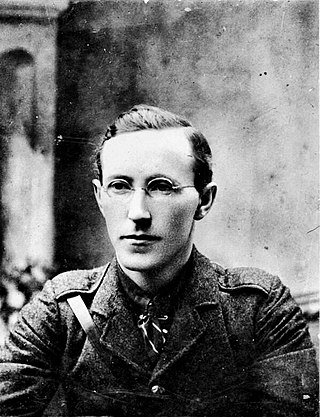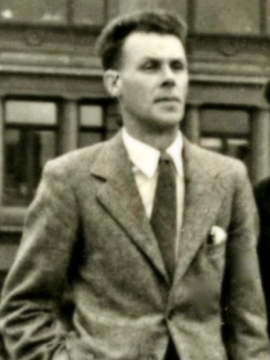Related Research Articles

The Irish Civil War was a conflict that followed the Irish War of Independence and accompanied the establishment of the Irish Free State, an entity independent from the United Kingdom but within the British Empire.

The Irish War of Independence or Anglo-Irish War was a guerrilla war fought in Ireland from 1919 to 1921 between the Irish Republican Army and British forces: the British Army, along with the quasi-military Royal Irish Constabulary (RIC) and its paramilitary forces the Auxiliaries and Ulster Special Constabulary (USC). It was part of the Irish revolutionary period.
Events from the year 1922 in Ireland.

Thomas Bernardine Barry, better known as Tom Barry, was a prominent guerrilla leader in the Irish Republican Army (IRA) during the Irish War of Independence and the Irish Civil War. He is best remembered for orchestrating the Kilmichael ambush, in which he and his column wiped out a 18-man patrol of Auxiliaries, killing sixteen men.

William Fanaghan Lynch was an officer in the Irish Republican Army during the Irish War of Independence of 1919–1921. During much of the Irish Civil War, he was chief of staff of the Irish Republican Army. On 10 April 1923, Lynch was killed whilst trying to escape an encirclement by Free State troops in south Tipperary.

The Irish Republican Army (IRA) is a name used by various paramilitary organisations in Ireland throughout the 20th and 21st centuries. Organisations by this name have been dedicated to anti-imperialism through Irish republicanism, the belief that all of Ireland should be an independent republic free from British rule.

The Irish Republican Army of 1922–1969, an anti-Treaty sub-group of the original Irish Republican Army (1919–1922), fought against the British-backed Irish Free State in the Irish Civil War, and its successors up to 1969, when the IRA split again into the Provisional IRA and Official IRA. The original Irish Republican Army fought a guerrilla war against British rule in Ireland in the Irish War of Independence between 1919 and 1921. Following the signing of the Anglo-Irish Treaty on 6 December 1921, the IRA in the 26 counties that were to become the Irish Free State split between supporters and opponents of the Treaty. The anti-Treatyites, sometimes referred to by Free State forces as "Irregulars", continued to use the name "Irish Republican Army" (IRA) or in Irish Óglaigh na hÉireann, as did the organisation in Northern Ireland which originally supported the pro-Treaty side. Óglaigh na hÉireann was also adopted as the name of the pro-Treaty National Army, and remains the official legal title of the Irish Defence Forces.
The Dublin Guard was a unit of the Irish Republican Army during the Irish War of Independence and then of the Irish National Army in the ensuing Civil War.
The Irish Republican Army was a guerrilla army that fought the Irish War of Independence against Britain from 1919–1921. It saw itself as the legitimate army of the Irish Republic declared in 1919. The Anglo-Irish Treaty, which ended this conflict, was a compromise which abolished the Irish Republic, but created the self-governing Irish Free State, within the British Empire. The IRA was deeply split over whether to accept the Treaty. Some accepted, whereas some rejected not only the Treaty but also the civilian authorities who had accepted it. This attitude eventually led to the outbreak of the Irish Civil War in late June 1922 between pro- and anti-Treaty factions.
The Irish Free State offensive of July–September 1922 was the decisive military stroke of the Irish Civil War. It was carried out by the National Army of the newly created Irish Free State against anti-treaty strongholds in the south and southwest of Ireland.

The executions during the Irish Civil War took place during the guerrilla phase of the Irish Civil War. This phase of the war was bitter, and both sides, the government forces of the Irish Free State and the anti-Treaty Irish Republican Army (IRA) insurgents, used executions and terror in what developed into a cycle of atrocities. From November 1922, the Free State government embarked on a policy of executing Republican prisoners in order to bring the war to an end. Many of those killed had previously been allies, and in some cases close friends, of those who ordered their deaths in the civil war. In addition, government troops summarily executed prisoners in the field on several occasions. The executions of prisoners left a lasting legacy of bitterness in Irish politics.
This is a timeline of the Irish Civil War, which took place between June 1922 and May 1923. It followed the Irish War of Independence (1919–1921), and accompanied the establishment of the Irish Free State as an entity independent from the United Kingdom of Great Britain and Ireland.
The Battle of Kilmallock took place between 25 July and 5 August 1922 in County Limerick, Ireland. It was one of the largest engagements of the Irish Civil War.

The Strand Barracks is the former army barracks on Clancy's Strand in Limerick city, Ireland.

George Lennon was an Irish Republican Army leader during the Irish War of Independence and the Irish Civil War.

William Richard English-Murphy, DSO MC known as W.R.E. Murphy was an Irish soldier and policeman. He served as an officer with the British Army in the First World War and later in the National Army. In the Civil War he was second in overall command of the National Army from January to May 1923. He was first Irish Commissioner of the Dublin Metropolitan Police and the last Commissioner of the force before its merger with the Garda Síochána in 1925. Thereafter he was the Deputy Commissioner of the Gardaí until his retirement in 1955.

John T. Prout was an Irish soldier. He served in the United States Army in the First World War, as a training officer in the guerrilla Irish Republican Army during the Irish War of Independence (1919–1921) and held one of the senior commands in the National Army during the Irish Civil War (1922–23).
The guerrilla phase of the Irish Civil War began in August 1922, when the forces of the Irish Free State took all the fixed positions previously held by the Anti-Treaty IRA. The IRA then waged a guerrilla war to try to bring down the new Irish Government and overturn the Anglo-Irish Treaty. This guerrilla campaign was ultimately defeated.

The National Army, sometimes unofficially referred to as the Free State army or the Regulars, was the army of the Irish Free State from January 1922 until October 1924. Its role in this period was defined by its service in the Irish Civil War, in defence of the institutions established by the Anglo-Irish Treaty. Michael Collins was the army's first commander-in-chief until his death in August 1922.

The Irish soviets were a series of self-declared soviets that formed in Ireland during the revolutionary period of the Irish War of Independence and the Irish Civil War, mainly in the province of Munster. "Soviet" in this context refers to a council of workers who control their place of work, not a Soviet state.
References
- ↑ Harrington, Michael (2010). Munster Republic: The Civil War in North Cork. Mercier Press. p. 51. ISBN 978-1-85635-656-5.
- ↑ Harrington, Niall C. (1992). Kerry Landing. Tralee: Anvil Books. p. 193. ISBN 0-947962-70-0.
- ↑ Walsh, Oonagh (2003). Ireland's Independence: 1880-1923. Routledge. p. 98. ISBN 978-1-134-55367-9.
Cork, the most important city in the `Munster Republic', fell on 11 August